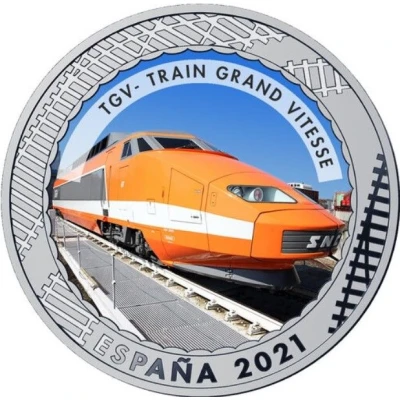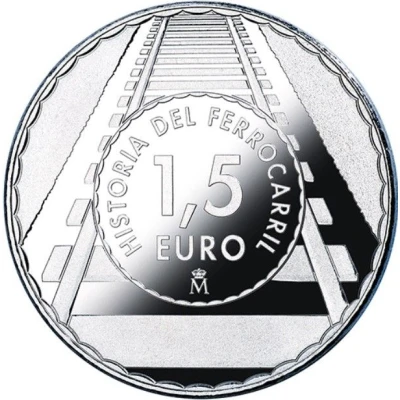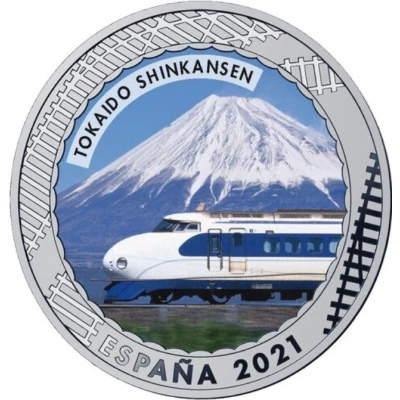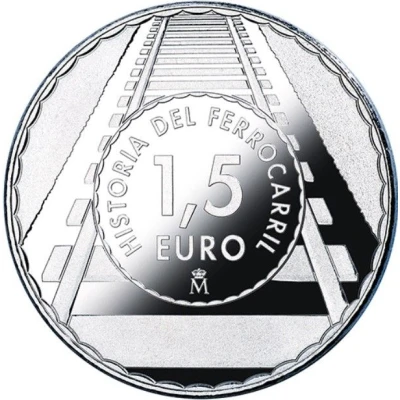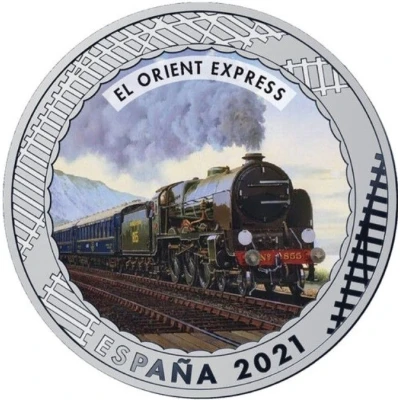
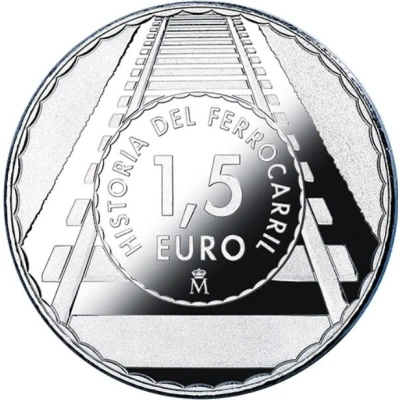

© Real Casa de la Moneda
1.5 Euro The Orient Express
2021 year| Copper-nickel (75% copper, 25% nickel) | 15 g | 33 mm |
| Issuer | Spain |
|---|---|
| King | Felipe VI (2014-date) |
| Type | Non-circulating coin |
| Year | 2021 |
| Value | 1.5 Euro 1.50 EUR = USD 1.65 |
| Currency | Euro (2002-date) |
| Composition | Copper-nickel (75% copper, 25% nickel) |
| Weight | 15 g |
| Diameter | 33 mm |
| Shape | Round |
| Technique | Milled, Coloured |
| Orientation | Medal alignment ↑↑ |
| Updated | 2024-10-07 |
| Numista | N#320573 |
|---|---|
| Rarity index | 90% |
Reverse
Series and face value inside a central circle. Outside the central circle, an image of a railway track.
Script: Latin
Lettering:
HISTORIA DEL FERROCARRIL
1,5 EURO
M
Translation: History of railways
Edge
Plain
Comment
For the year 2021, since the European Year of the Rail and the 80th Anniversary of Renfe are celebrated, the FNMT-RCM issues a collection of 20 coins dedicated to the History of the Railways. This series reproduces a selection of trains and locomotives that have been relevant throughout its history.The Orient Express: The Orient Express is one of the most iconic trains ever to have existed. Its arrival was perfectly timed in that, with the establishment of a railway network in Europe in the last 30 years or so of the nineteenth century, tourism had become a social phenomenon.
It was Belgian engineer Nagelmackers who set up the Compagnie Internationale des Wagons-Lits with a view to providing a select service which would enhance the idea of rail travel for tourism even further. And so the Orient Express came into being as a great express train, whose main distinguishing feature was that it was a luxury train made up of sleeping cars and a restaurant car.
The Orient Express set off from Paris on its maiden journey on June 5 1883 with 33 passengers, mostly British. At 19.30, it pulled out of Strasbourg Station (now Paris-Est) bound for Istanbul, calling at the cities of Strasbourg, Munich, Vienna, Budapest and Bucharest. Initially, from Giurgiu Station (Romania) to Constantinople, passengers had to continue the journey aboard other trains but, from June 1 1889, the whole route could be travelled without the need to change. The complete return journey between the two cities took 13 days.
Once things had returned to normal after the Great War, the Orient Express witnessed its two golden decades. In this, a decisive role was played by the new, southern route, the Venice-Simplon Orient Express, as the opening of the Simplon Tunnel meant that iconic Venice could be included in the journey.
It is no coincidence that Agatha Christie should have published her novel, Murder on the Orient Express, in 1934, thereby turning the train into a universal myth. Reality, however, told a different story as first, the train was erased in the Second World War and second, the complications of the Cold War rendered its recovery impossible. On May 20 1977, it made its last direct journey from Paris to Istanbul. Nevertheless, like Phoenix rising from the ashes, it was born again thanks to the Belmond Company, whose representatives zealously claim that “the train epitomises the glamour and elegance of the golden age of travel”.
Interesting fact
The Orient Express coin's design features a train locomotive, specifically the SNCF 242 A 1, which was used by the famous Orient Express train service that connected Paris and Istanbul from 1883 to 2009.
Price
| Date | Mintage | VG | F | VF | XF | AU | UNC |
|---|---|---|---|---|---|---|---|
| 2021 M | 7000 | - | - | - | - | - | - |
Values in the table are based on evaluations by sales realized on Internet platforms. They serve as an indication only for 1.5 Euro (The Orient Express) 2021 coin.
